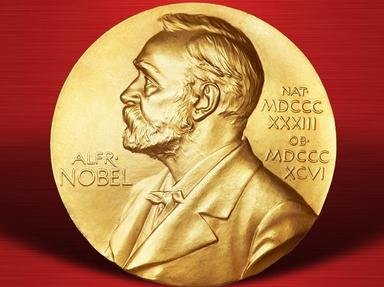Quiz Answer Key and Fun Facts
1. The first year that Nobel Prizes were awarded was 1901, with six recipients in five categories. The Nobel Prize in Physics was presented "in recognition of the extraordinary services he has rendered by the discovery of the remarkable rays subsequently named after him." Who received the Prize?
2. Ten years after the inception of the Nobel Prize, this lady received her second award. She won the first along with her husband in 1903 in the field of Physics, and in 1911 she won it for Chemistry. Who was this lady?
3. The recipient of the Nobel Prize for Physics in 1921 did not actually receive the accolade until 1922, as it was determined that none of the nominees that year fulfilled the criteria outlined in Alfred Nobel's will. The statutes allowed for a delay of one year, thus enabling the bestowing of the Prize to this man "for his services to Theoretical Physics, and especially for his discovery of the law of the photoelectric effect." Who won the prize?
4. The awards speech in 1931 for Otto Heinrich Warburg began "The discovery for which the Nobel Prize for _______ is to be awarded today concerns intracellular combustion." Which category completes the sentence?
5. Another ten years brings us to 1941. Due to World War II, no Nobel Prizes are awarded over a six year stretch, from 1940 until 1945 inclusive.
6. The 1951 recipient of the Nobel Prize for Literature went to a Swedish writer "for the artistic vigour and true independence of mind with which he endeavours in his poetry to find answers to the eternal questions confronting mankind." Among his works cited in the presentation speech were "Ordkonst och bildkonst" (Verbal Art and Pictorial Art), and "Onda Sagor" (Evil Tales). Who won the prize?
7. Another decade gone, and a new first for the Nobel Prize. In 1961, Dag Hjalmar Agne Carl Hammarskjöld was the first and only person to receive a Prize posthumously. Hammarskjöld was the United Nations' second Secretary-General, serving from 1953 until his death in 1961. How did this Nobel Peace Prize recipient die?
8. A new Nobel Prize category was introduced at the end of the 1960s, and in 1971 the third person to win the Prize was economist Simon Smith Kuznets "for his empirically founded interpretation of economic growth which has led to new and deepened insight into the economic and social structure and process of development." What is the full title of this category?
9. The 1981 recipient for the Nobel Prize in Literature was a Hungarian-born writer whose early life was lived in German-speaking countries (Austria, Switzerland and Germany) and who eventually became a British citizen in 1952. He received the Award "for writings marked by a broad outlook, a wealth of ideas and artistic power." Which Antarctic mountain is named after him?
10. This 1991 Nobel Peace Prize winner spent the bulk of twenty years under political house arrest in her home in Rangoon after her political party won the Burmese election in 1990 and the military regime would not cede power. She was finally released on November 13th, 2010. Who is this amazing woman?
Source: Author
reedy
This quiz was reviewed by FunTrivia editor
bloomsby before going online.
Any errors found in FunTrivia content are routinely corrected through our feedback system.
